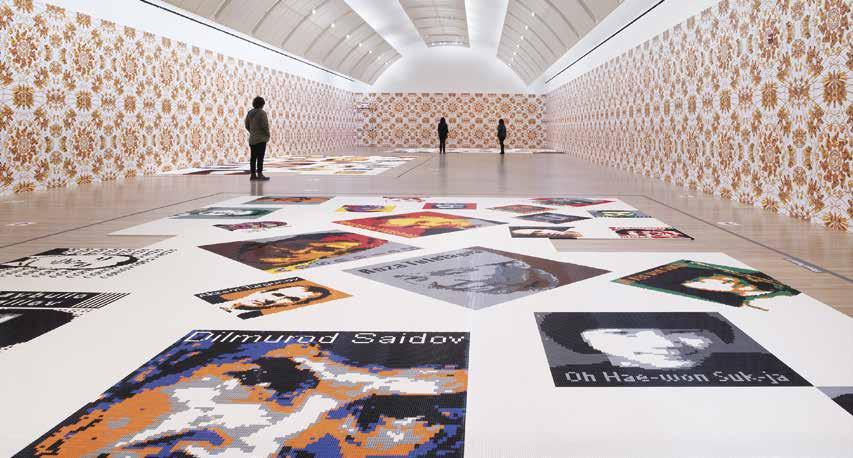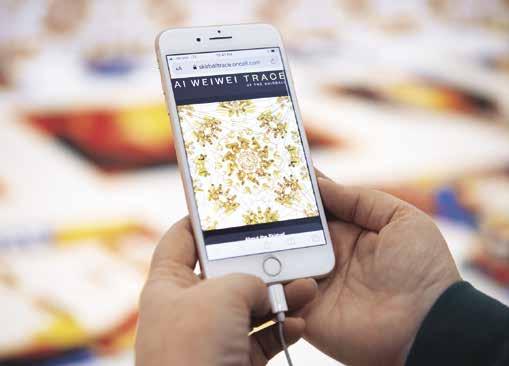
3 minute read
Connected in Conscience
Artist Ai Weiwei’s installation assembled from LEGO® bricks illuminated our shared humanity.
The Skirball reopened its doors in May of 2021 to a culture of perspectives drastically altered by the events of the past year. In addition to experiencing the devastations of the pandemic, our nation and the world witnessed numerous instances of police brutality toward Black people, a staggering rise in anti-Asian hate crimes, and a disturbing surge in anti-Semitism. In response to these atrocities, a groundswell of social justice advocates found their voice. Demanding respect for human dignity became a global movement. In the midst of this historic moment, the exhibition Ai Weiwei: Trace opened at the Skirball, underscoring how resistance is integral to upholding the American ideals of freedom and equality.
Right: Organized by the Hirshhorn Museum and Sculpture Garden, Smithsonian Institution, Washington, DC, the Skirball’s presentation of Ai Weiwei: Trace included a mobile guide, narrated by Skirball employees, that shared the stories of the individuals depicted in Ai’s portraits. Scan the QR code below to hear their heroic acts recounted!

Robert Wedemeyer
Featuring eighty-three LEGO® brick portraits of political prisoners, Ai Weiwei: Trace originated during Ai’s own experience of incarceration. In 2011, the Chinese government kept the Beijing-born artist—whose father, a poet, was exiled to remote northwest China—under house arrest for eighty-one days and prohibited Ai from traveling abroad until 2015. His son’s interest in LEGO®, the universally popular and easily accessible children’s building blocks, inspired the medium with which he represented his fellow activists, prisoners of conscience, and advocates of free speech. Each portrait is handmade from thousands of LEGO® bricks. Ai ultimately created 176 portraits, displayed in six floor panels, which were first presented in 2014 as part of @Large: Ai Weiwei on Alcatraz. Three of those panels were on view at the Skirball. Alongside widely celebrated figures like Martin Luther King Jr. and Nelson Mandela, Ai featured lesserknown activists, whom he has described as “heroes of our time,” who likewise fought injustice in their communities. Portrayed in LEGO® of gold, brown, and shades of gray, newspaper editor Agnes Uwimana Nkusi of Rwanda was arrested in 2010 after criticizing government policies and alleging corruption in the upcoming election. Depicted in red and shades of gray LEGO®, former CIA officer and counterterrorism official John Kiriakou of the United States was imprisoned for thirty months after he publicly discussed the suffocation technique known as waterboarding. Nguyen Doan Quoc Hung of Vietnam, illustrated in green, orange, light blue, and gray LEGO®, was sentenced to nine years in prison after supporting workers striking in a shoe factory. “After seeing protestors and activists from around the world, it was a jolt to see Chelsea Manning and [Edward] Snowden. It challenged my reactions to their acts of conscience,” said one Skirball visitor. Ai complemented these portraits with an adaptation of his wallpaper installation entitled The Plain Version of the Animal That Looks Like a Llama but Is Really an Alpaca. Within the stunning wallpaper pattern, Ai incorporated an array of iconography critiquing authoritarianism, including alpacas (a symbol of freedom of expression in Chinese internet culture), surveillance cameras, handcuffs, and Twitter bird logos. “This is a very important work for me to directly reflect on humanity, human rights, and the freedom of speech,” Ai stated in the virtual tour of the exhibition. “As we know, in today’s world, those issues are still very crucial issues. And that we have to protect human rights and the freedom of speech. And this is the foundation for civilized society.” Skirball curator Yael Lipschutz interviewed Ai in an online public program previewing the exhibition’s opening. Their discussion of the interconnectedness of global crises and the ways art can advance social justice attracted nearly 6,000 viewers. From May to August 2021, Ai Weiwei: Trace offered a space for Skirball visitors to make those connections across national borders and cultural distinctions and foregrounded the potential within each of us to stand up for a more just world.
Facing page: Skirball visitors viewed Ai Weiwei’s singular artistic vision in the expansive installation. Ai’s eclectic body of work comprises sculpture, photography, film, painting, and architecture.









